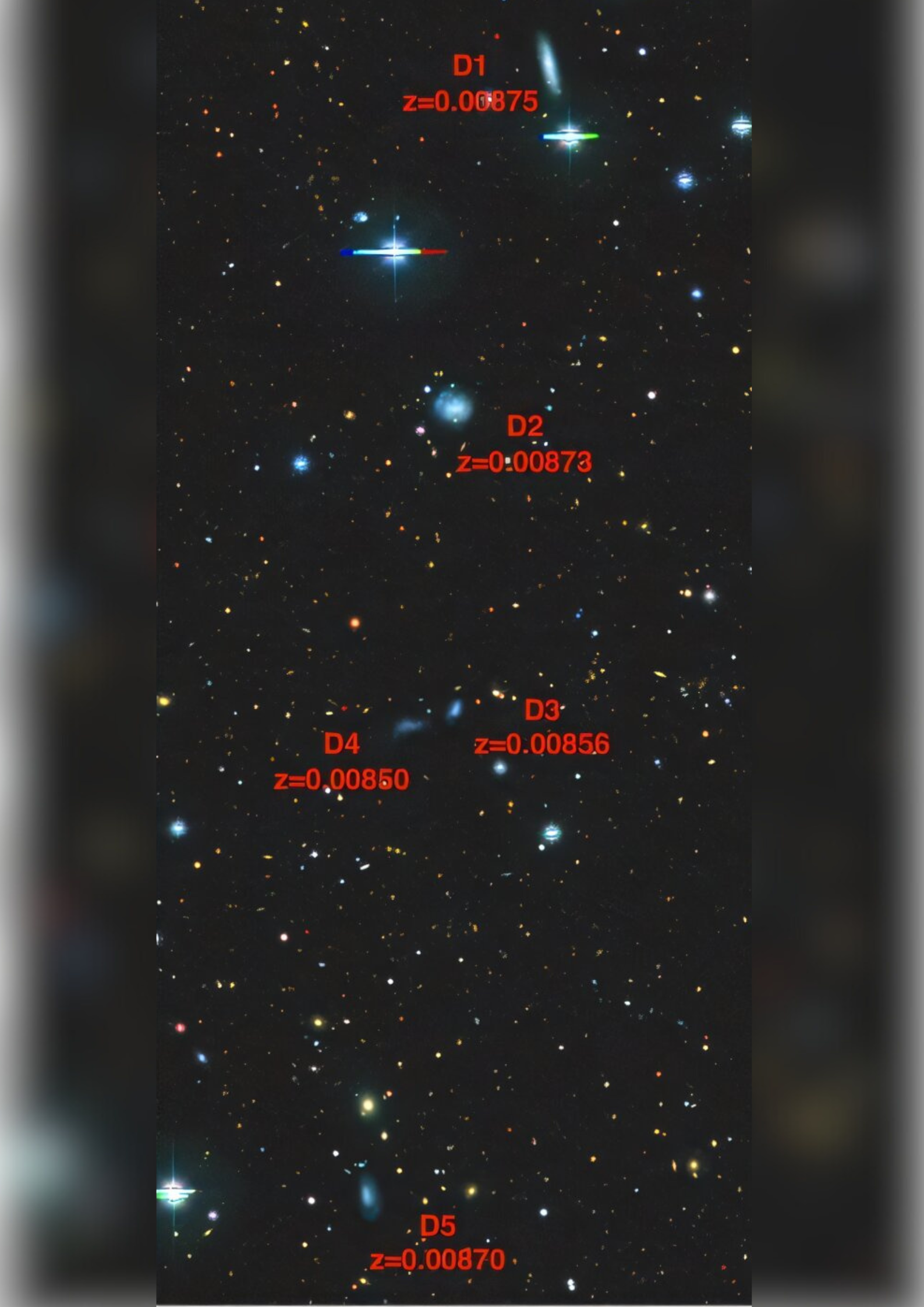Astronomers have discovered a rare group of five dwarf galaxies located relatively close to Earth; these galaxies exist in a near-perfect alignment, resembling a string of cosmic pearls in the sky.
Held together by their mutual gravity, several of the dwarf galaxies (designated D1 to D5) are rhythmically dancing with one another while others are engaged in a “cosmic tug of war,” ripping gas and stars away from each other.
The scientists behind this discovery say these factors make this dwarf galaxy grouping particularly intriguing. The arrangement may be as challenging as it is beautiful, potentially posing a problem for our best model of cosmic evolution.
The observed dwarf galaxies sit relatively close to Earth at just around 117 million light-years away.
“These galaxies are small, faint and rich in gas, yet all of them are actively forming new stars — a surprising trait for dwarf galaxies in a group,” team leader Cristiano G. Sabiu of the University of Seoul told Space.com. “Even more striking is their nearly perfect alignment in the sky, forming a distinct ‘string of cosmic pearls.'”
The galaxies were discovered via data from the Sloan Digital Sky Survey (SDSS), which mapped one-quarter of the entire sky over Earth in great detail, determining the positions and absolute brightnesses of hundreds of millions of celestial objects. Data from several other astronomical surveys also aided the discovery team.
Dwarf galaxies dancing and holding hands
As the name implies, dwarf galaxies are low-mass realms with low stellar populations, which means they are also rather dim in terms of brightness. The total mass of these five dwarf galaxies appears to be around 60.2 billion solar masses (one solar mass being equivalent to the mass of the sun). For comparison, our galaxy, the Milky Way, is estimated to have a mass that is equivalent to around 1.5 trillion suns.
The most massive of these five dwarf galaxies (D2) has a mass equivalent to just 275 million suns. The least massive, D4, has a mass of just 14.7 million solar masses. That means, while D1 to D5 fit in well in terms of other dwarf galaxy characteristics, they are major outliers in terms of their companionship.
Dwarf galaxies tend to be fairly lonesome, with less than 5% found with close galactic companions. The chance of finding five dwarf galaxies grouped together as they are in this case is less than 0.004%.
“This unusual arrangement raises the question,” Sabiu said. “Is this alignment a mere coincidence, or does it hint at a deeper connection related to their formation and evolution?”
Sabiu continued by explaining that the fact that three of these dwarf galaxies (D1, D2 and D5) share the same rotational direction adds to the uniqueness of this arrangement.
“It is as if performing a synchronized cosmic dance,” Sabiu added. “This could provide valuable clues about their shared origins or the role of their environment in shaping their motions.”
Two dwarf galaxies are actively interacting in a galactic “tug of war” contest contributing to the mystery of this galactic grouping. This gravitational interaction pulls matter from the galaxies, forming visible “tidal tails” of gas and stars.
“Such interactions often trigger bursts of star formation and can significantly alter a galaxy’s shape over time,” Sabiu explained.
Sabiu explained why the discovery of these dwarf galaxies challenges our best theory of cosmic evolution, the standard model of cosmology, or the Lambda Cold Dark Matter (LCDM) model.
“This discovery poses a challenge to the LCDM model, as it may struggle to account for the formation of such small, aligned groups of galaxies in isolated environments,” the researcher said.
The team’s research was published in November in The Astrophysical Journal Letters.
Article by:Source























